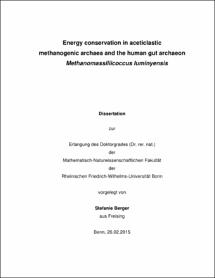Berger, Stefanie: Energy conservation in aceticlastic methanogenic archaea and the human gut archaeon Methanomassiliicoccus luminyensis. - Bonn, 2015. - Dissertation, Rheinische Friedrich-Wilhelms-Universität Bonn.
Online-Ausgabe in bonndoc: https://nbn-resolving.org/urn:nbn:de:hbz:5n-40879
Online-Ausgabe in bonndoc: https://nbn-resolving.org/urn:nbn:de:hbz:5n-40879
@phdthesis{handle:20.500.11811/6516,
urn: https://nbn-resolving.org/urn:nbn:de:hbz:5n-40879,
author = {{Stefanie Berger}},
title = {Energy conservation in aceticlastic methanogenic archaea and the human gut archaeon Methanomassiliicoccus luminyensis},
school = {Rheinische Friedrich-Wilhelms-Universität Bonn},
year = 2015,
month = jul,
note = {Methanogenic Archaea produce methane from products of anaerobic bacterial metabolism. Therefore, they play a central role in global carbon cycling. The fact that methane is a potent green house gas further stresses the ecological relevance of methane producing Archaea. Furthermore, in recent years several new methanogenic species from the human gastrointestinal tract have been identified, which might be beneficial for the human host.
In this study energy conservation of the aceticlastic methanogenic Archaea Methanosaeta (Mt.) thermoacetophila and Methanosarcina (Ms.) mazei as well as energy conservation in Methanomassiliicoccus (Mm.) luminyensis from the human gut has been investigated.
First, the acetate activation reaction in Mt. thermoacetophila was examined in detail. It was found that the AMP-forming acetyl-CoA synthetase Mthe1194 and a soluble pyrophosphatase (Mthe0236) are involved in the acetate activation reaction. Thus, two ATP equivalents are spent for acetate activation in Mt. thermoacetophila that have to be regained by membrane-bound enzymes of the respiratory chain. Interestingly, in Mt. thermoacetophila the Fpo complex can be found, which is known to oxidize the electron carrier F420H2 and channels electrons into the respiratory chain. However, no F420H2 is built during aceticlastic methanogenesis. Instead, electrons are transferred to ferredoxin. In the course of this study it was shown that in the model organism Ms. mazei the Fpo complex is able to accept electrons not only from F420H2 but also from reduced ferredoxin. The reaction might enable the translocation of three protons across the cytoplasmic membrane instead of two as was previously described. This provides a possible explanation how Mt. thermoacetophila can grow with acetate as substrate.
Mm. luminyensis uses H2 and methylated compounds as substrates. H2 is used as electron donor and is oxidized via the MvhADG/HdrABC complex. This complex produces reduced ferredoxin that has to be oxidized by membrane-bound enzyme(s). In this study, activity of the Ech hydrogenase from the family of energy converting hydrogenases was demonstrated and thus Mm. luminyensis might conserve energy by translocating protons via the Ech hydrogenase.},
url = {https://hdl.handle.net/20.500.11811/6516}
}
urn: https://nbn-resolving.org/urn:nbn:de:hbz:5n-40879,
author = {{Stefanie Berger}},
title = {Energy conservation in aceticlastic methanogenic archaea and the human gut archaeon Methanomassiliicoccus luminyensis},
school = {Rheinische Friedrich-Wilhelms-Universität Bonn},
year = 2015,
month = jul,
note = {Methanogenic Archaea produce methane from products of anaerobic bacterial metabolism. Therefore, they play a central role in global carbon cycling. The fact that methane is a potent green house gas further stresses the ecological relevance of methane producing Archaea. Furthermore, in recent years several new methanogenic species from the human gastrointestinal tract have been identified, which might be beneficial for the human host.
In this study energy conservation of the aceticlastic methanogenic Archaea Methanosaeta (Mt.) thermoacetophila and Methanosarcina (Ms.) mazei as well as energy conservation in Methanomassiliicoccus (Mm.) luminyensis from the human gut has been investigated.
First, the acetate activation reaction in Mt. thermoacetophila was examined in detail. It was found that the AMP-forming acetyl-CoA synthetase Mthe1194 and a soluble pyrophosphatase (Mthe0236) are involved in the acetate activation reaction. Thus, two ATP equivalents are spent for acetate activation in Mt. thermoacetophila that have to be regained by membrane-bound enzymes of the respiratory chain. Interestingly, in Mt. thermoacetophila the Fpo complex can be found, which is known to oxidize the electron carrier F420H2 and channels electrons into the respiratory chain. However, no F420H2 is built during aceticlastic methanogenesis. Instead, electrons are transferred to ferredoxin. In the course of this study it was shown that in the model organism Ms. mazei the Fpo complex is able to accept electrons not only from F420H2 but also from reduced ferredoxin. The reaction might enable the translocation of three protons across the cytoplasmic membrane instead of two as was previously described. This provides a possible explanation how Mt. thermoacetophila can grow with acetate as substrate.
Mm. luminyensis uses H2 and methylated compounds as substrates. H2 is used as electron donor and is oxidized via the MvhADG/HdrABC complex. This complex produces reduced ferredoxin that has to be oxidized by membrane-bound enzyme(s). In this study, activity of the Ech hydrogenase from the family of energy converting hydrogenases was demonstrated and thus Mm. luminyensis might conserve energy by translocating protons via the Ech hydrogenase.},
url = {https://hdl.handle.net/20.500.11811/6516}
}






